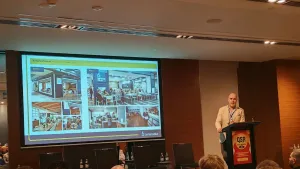
"Restaurant within a Restaurant" - What You Should Know About Virtual Brands
The food delivery industry is one of the fastest growing sectors in Australia. According to a report by IBISWorld, food delivery is predicted to be a $365B global market by 2030. In Australia, this industry grew by 81.1% between 2015 and 2020. Annually, 68 million food orders were placed in Australia—equivalent to 7,000 orders per hour!
This growth is being driven by an increase in the number of ordering platforms and restaurants offering online ordering services including the new king in town: virtual brands. With no expensive fit-out, no front-of-house staff or kitchen facilities, virtual brands are a much cheaper proposition for QSR owners looking for additional revenue.
In this article, we'll explain what a virtual brand is, how it works—and how QSRs can adopt this strategy.
Defining virtual brand
Often described as a “restaurant within a restaurant,” a virtual brand is one that exists digitally, but with no physical presence—it's simply an extension of a QSR’s current operation!
Virtual brands are digital storefronts on delivery platforms like Uber Eats, Menulog and Doordash. Their name reflects the fact that customers can only order from these restaurants online—they don’t have actual physical locations where people gather to eat together.
With virtual brands, QSRs can add an additional revenue stream by offering delivery-only products. Using the restaurant's existing kitchen space, equipment, pantry items and staff, virtual brands allow business owners to offer more than their current menus without expanding operations or hiring new workers.
Virtual brands are an effective way to grow a QSR business without the cost and risk associated with building a brick-and-mortar location. QSRs can implement virtual brands quickly across their existing business working models, meaning they won't have to hire additional employees or buy new equipment.
Leveraging virtual brands for business growth
With the help of virtual brands, QSRs can maximise their underutilised kitchens to generate additional revenue streams. Because they can be deployed on existing systems, virtual brands can significantly raise the efficiency of restaurants and increase their profitability.
Virtual brands are a great way to try out new things with little risk involved—all while giving QSR customers something new on the menu. By leveraging the resources already in place, virtual brands can offer customers an expanded menu without any additional overhead costs associated with operating a second kitchen or hiring additional staff members.
Virtual brands are ideal for QSRs that already offer takeout or delivery services because they allow QSRs to add on more menu items without making major changes to the kitchen or staff workloads. By partnering with a virtual brand system like Concept 8, QSRs can get started right away.
Introducing Concept 8 Virtual Brands
Concept 8 is one of Australia's largest multi-brand franchisors, with over 27 years' experience in the retail food industry. The company offers a carefully developed suite of virtual brands to support existing businesses with 190+ virtual brands operating nationally.
Concept 8 Virtual Brands is designed to easily fit within various types of existing commercial QSR kitchen environments through their own unique menu items that suit the needs of modern consumers who are looking for alternatives to traditional fast food options but still want great tasting food at a reasonable price point.
Working with C8 Virtual Brands
C8 Virtual Brands partners with strong experienced operators looking to increase their revenue anywhere popular food delivery services are available. QSRs can choose from offers a range of food styles through its virtual brand portfolio like noodles, dumplings, Korean fried chicken and even plant-based options.
The company helps the Australian hospitality community generate additional revenue and sources of income through providing the expertise and know-how of a proven national food franchise network. Its key support services include operations, training, marketing, legal, financial, supply chain, project management and network development.
Distinguishing virtual brands from franchises
Concept 8 virtual brands are also franchises, meaning QSRs get the full support and knowledge from the franchisor. This can be invaluable to a small business operator as they can take advantage of proven processes and practices and don’t have to worry about managing key elements like marketing, supply chain and training.
While a virtual brand does not have an actual location, it offers the opportunity to reach thousands of new customers and make QSRs business highly efficient (and therefore highly profitable) by maximising an operational commercial kitchen.
Whereas franchise brand is a fully functional visible restaurant with a dine in option plus delivery sometimes. The investment is significantly more to own a standalone franchise as a partner, in comparison to a virtual brand that can be added to an existing business.
Key Takeaway
It's no secret that the QSR industry is one of the most competitive in the world. There are thousands of restaurants out there, each trying their best to stand out from the rest. This can be especially difficult if a business doesn't have a large budget or staff to work with - but with virtual brands, it doesn't have to be! Virtual brands allow any business owner or entrepreneur to explore a new food service without having to build up another full kitchen. They can be easily added to an existing business with minimal investment - and can help QSRs take their business to the next level.
If you’re interested to know more or how C8 Virtual Brands can help your business, contact Adam Howatt at [email protected]
























